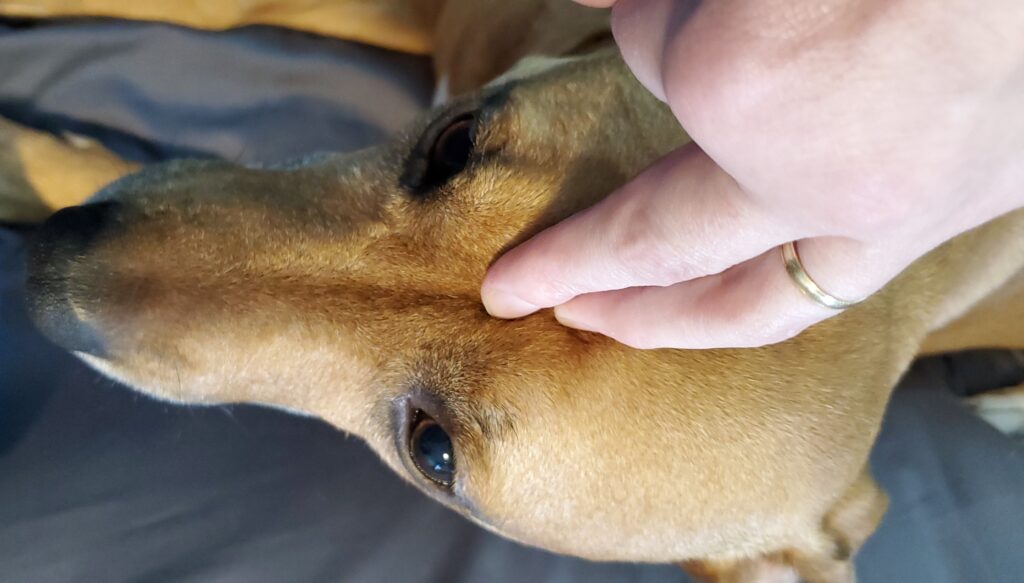Cats and dogs are highly sensitive to physical touch and energy flow from humans. We can help our pets by employing special massage techniques and strategies catered for their unique senses.
Complex Senses
Gifted with heightened senses of vision, hearing and smell originating from their ancestral need to survive in the wild – domesticated cats and dogs constantly survey their surroundings. Even while sleeping, many pets will quickly awaken in response to aromatic food or a curious noise. When a dog barks or a cat jumps and runs for what seems like no apparent reason, they likely hear a sound or smell an odor that we cannot sense.
Cats and dogs hear various frequencies of sound including high-pitched levels that are inaudible to people. For example, humans generally perceive low electronic hums from appliances and computers as background noise; but our furry friends hear the same high-pitched buzzing as louder and more intense. This remarkable auditory perception is largely responsible for pets’ anxiety during events including grooming, home remodeling, thunderstorms and fireworks.
Justine Cosley, certified master feline groomer by the National Cat Groomers Institute of America and owner at Cat Around Town located in West Mifflin, Pa., also has past experience as a veterinary technician. She grooms only cats in her facility where her focus is on grooming sensitive and special needs cats without any sedation – a unique service when sedative medication cannot be tolerated due to an animal’s age or medical status. To accommodate cats’ extreme sensitivity to noise, Ms. Cosley places cotton in cats’ ears during grooming sessions. She also uses a lightweight fabric band that expands to wrap around any kitty’s head (pictured) to shield their ears from noise and air pressure during blow drying. The fabric band around their head also mimics the feeling of being held or hiding in an enclosed bed or tunnel toy, further increasing felines’ comfort.
Acupressure and Energy
Acupressure is an ancient massage technique used in Traditional Chinese Medicine to assist with various issues including anxiety, nausea and pain. Michelle Elgersma, DVM, certified in veterinary acupuncture by the International Veterinary Acupuncture Society since 2012, explains that acupressure is similar to acupuncture. The main difference is that acupressure requires less precision because we use our thumb or finger, covering a larger surface area than an acupuncture needle. Therefore, anyone can learn to how to rub and press certain points on a pet’s body to release and move meridian energy.
“Energy should always be in motion; if stuck, it can cause stagnation,” advises Dr. Elgersma.
Engaging in this natural form of healing likely will increase the bond between person and pet because you will cause the release of endorphins which combat stress and pain. Generally, most points that are useful on humans also are effective on cats, dogs, rabbits and horses. Dr. Elgersma favorite two points to gently massage on your pet are as follows:
- For relaxation (illustration A).: Place thumb or first two fingers at the center of pet’s nose and stroke through the middle of the eyes and ears, as if drawing a center line. Repeat as needed.
Natural Therapies to Reduce Stress in Cats and Dogs
- For calmness (illustration B): On the back of pet’s neck, place index and middle finger behind one ear. Spread hand to place thumb behind pet’s other ear. Then press in toward pet's skull and hold for several seconds. (My dog became so calm that he fell onto the floor!)
More acupressure methods and detailed charts of points on pets’ bodies are available online from various resources. Please consult with your veterinarian for concerns or questions about acupressure and your pet.
References
Animal Medical New City. Accessed 24 Feb. 2021.
https://animalmedicalnc.com/project/acupressure- for-pets/
Texas A&M University Veterinary Medicine & Biomedical Sciences. 22 Jan. 2019.
https://vetmed.tamu.edu/news/pet-talk/a-cats-five-senses/
The University of Adelaide, Faculty of Sciences. “How far away can dogs smell and hear?” 9 Jan. 2020.
https://sciences.adelaide.edu.au/news/list/2020/06/09/how-far-away-can-dogs-smell-and-hear



